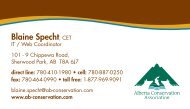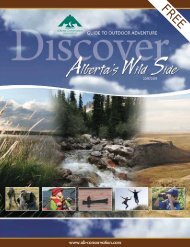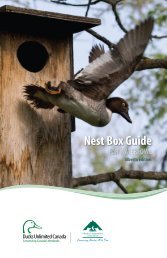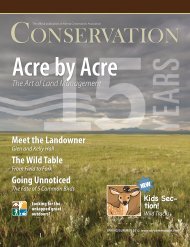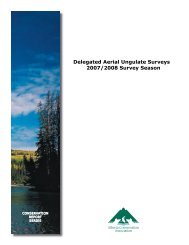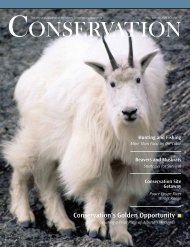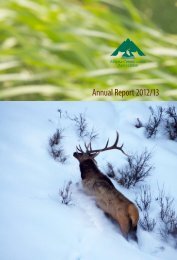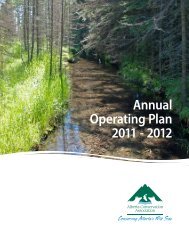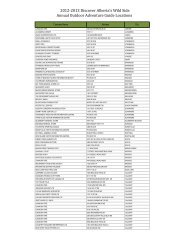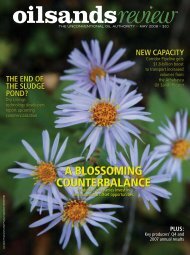Alberta's Ring-necked Pheasant - Alberta Conservation Association
Alberta's Ring-necked Pheasant - Alberta Conservation Association
Alberta's Ring-necked Pheasant - Alberta Conservation Association
- No tags were found...
You also want an ePaper? Increase the reach of your titles
YUMPU automatically turns print PDFs into web optimized ePapers that Google loves.
Location, Location,Location<strong>Ring</strong>-<strong>necked</strong> <strong>Pheasant</strong>s require a variety ofhabitats through the seasons, includingstanding grass, shrubby thickets, grain cropsand shelterbelts. The ideal situation forpheasants is to have all of these habitatsavailable in close proximity.Weedy areas forseeds and insectsNight-timeroosting areasThermal coverfor winterStanding grassesfor nestingGrit sourcefor hensFood sources forbuilding fat reservesand winter survivalShade and insectsfor chicks12
<strong>Alberta</strong>’s<strong>Ring</strong>-<strong>necked</strong><strong>Pheasant</strong>Through the SeasonsThe <strong>Ring</strong>-<strong>necked</strong> <strong>Pheasant</strong> has been a part of <strong>Alberta</strong>’s landscape forover one hundred years. A native of Asia, this colourful upland birdbrings a touch of the exotic to our farmlands, rangelands, wetlands,river valleys, roadsides, yards and parks.This booklet was developed in partnership with the <strong>Alberta</strong><strong>Conservation</strong> <strong>Association</strong> and <strong>Pheasant</strong>s Forever. It offers a glimpseinto the life of <strong>Alberta</strong>’s pheasants and highlights how their activitiesand habitat needs change through the seasons.For additional copies of this booklet contact:<strong>Alberta</strong> <strong>Conservation</strong> <strong>Association</strong>Toll-free number 1-877-969-9091E-mail info@ab-conservation.comWebsite www.ab-conservation.com1
FALLFall Feeding FrenzyIn the fall, there is a scramble to prepare forwinter. The roosters have been taking it easysince the breeding season and already havedecent fat reserves. For the hens, fall is aboutrebuilding fat reserves. The chicks are alsobusily building up body fat and by Octoberthey have reached adult size.The primary food on the menu at this time isgrain from crops. Weed seeds are also eaten,as they are relatively high in proteincompared to commercial grains. Sunflowerand foxtail seeds are a couple of the mostfavoured seeds.Kitchen Party<strong>Pheasant</strong>s are now concentratedwherever the eating is good. Corn fields,wheat fields, weedy areas and wetlandmargins are preferred areas. Towardsthe end of the fall, they start to drifttowards areas of thicker cover wherethey will be able to withstand thedecreasing temperatures and harsherconditions.10
<strong>Pheasant</strong>s need a mosaic of habitat types for feeding, nesting, raising young,escaping predators and surviving harsh winters. Their habitat requirementschange with the seasons. <strong>Pheasant</strong> populations are highest where all of theirseasonal requirements occur in close proximity. Examples of good yearroundpheasant habitat include small farms, wetland edges and river valleys.WINTERDecember to March - Survival!Dense vegetation is needed to providewarmth and protection, as well as fallengrain for food.FALLSeptember to NovemberGrowth & SurvivalProductive food sourcesare required to allowfattening up and growth.SPRINGApril to May - ReproductionGrassy fields are needed fornesting.SUMMERJune to August - Brood RearingThe chicks require cover to hide in andshady areas to prevent over-heating.3
SUMMERGender InequalityBy June, the roosters are already workingon gaining weight for the winter. They playno role in incubating or raising the young.The hens, however, are still hard at workand summer is all about raising theirchicks.Summer ChallengesJune is the peak hatching period forpheasant eggs. The chicks are precocial,meaning that they are immediately able torun around after hatching and they leavethe nest right away.For the first two weeks, the hens broodtheir chicks during cold nights as thechicks cannot regulate their own bodytemperature. Both high and lowtemperatures can quickly kill a chick in itsfirst two weeks.Most chick mortality occurs in the first 10to 12 days. By ten weeks, approximatelyhalf of the chicks that hatched will be dead.The main causes are extreme weather, lackof insects, predators and poor condition ofthe hen.By September, when the chicks are tenweeks old, they disperse and no longerstick together in family groups.Predation<strong>Pheasant</strong> chicks are vulnerable to a host ofpredators including foxes, coyotes, skunks,raccoons, badgers, owls, hawks andfalcons. The hen alerts the chicks topredators by giving a danger call. Thechicks scatter and freeze when they hearthis call.8
<strong>Pheasant</strong> DreamsAt night the birds roost in low, dense cover.Ungrazed pasture and hayland, cattails andbrushy cover provide good winter roostingopportunities.Daytime NappingDuring the day, the birds need taller “loafingcover” that provides insulation and protectionfrom birds of prey. Shrubs and low-growingtrees provide the best daytime roosting spots.Having both day and night roosting areas inclose proximity is ideal!Good winter cover can reduce the amount ofenergy required to stay warm by 25%. This canmean the difference between life and death.Winter Menu<strong>Pheasant</strong>s rely mostly on commercialgrains in winter. Changes in farmingpractices have resulted in less wastedgrain in fields, making it more difficultfor pheasants to find winter food.Cereal grains, weed seeds and forbs arean important food source, along withcorn and sunflowers where available.Food sources within 300 m of roostingareas minimize the amount of energyused for travel and reduces the risk ofpredation.5
SPRINGSpring FeverIn late March, winter flocks disperse andindividual birds spread out into nestingterritories. Mating and nesting starts in April,with most egg-laying occurring in May.What a Hen Wants...The perfect nest location is an idle grassy areawith last years grasses still standing upright. Thetall grasses provide camouflage and shelter forher nest.First is BestHens will re-nest if the firstclutch is unsuccessful. However,having a successful first nestimproves the chances of the henand her chicks surviving thewinter by up to 45%. The laterthe chicks hatch, the smallerthey will be when winter comesaround. Hens that nest late haveless body fat by winter thanthose that nested earlier.A single hen may lay more than 30 eggs in abreeding season! Many of these are laid beforeshe has even built a nest. These eggs are dumpedat random, which explains why you sometimessee a lone egg lying on the ground in an odd place.Once the hen is able to produce one egg a day, shebuilds a nest and fills it with one egg everymorning until there are 10 to 12. At that point shestarts incubating. This is a stressful time for thehen as she will spent 23 hours a day on the nest,taking only very short breaks to look for food. Ifall goes well, the eggs hatch 23 days later.Good pheasant nesting habitat6
Don’t Count Your Eggs Until They Are HatchedMay temperatures are critical in determining nest success. Beforethe hen starts incubating her eggs, they will freeze in cold weather.If there is a cold snap before she has begun incubating, any eggs laidbefore or during the cold snap will not hatch. High temperaturescan have a similar effect. Warmth causes the embryos to start todevelop before incubation begins, and once the temperature dropsto normal again, they will die.Because of the timing, nests that are built in alfalfa fields frequentlycome to a tragic end. Many hens and nests are destroyed by cuttingand swathing. Those that are not destroyed will likely be found bypredators because of the reduced cover after haying. One optionthat farmers have is to plant a later maturing variety of alfalfa.Spring Menu<strong>Pheasant</strong>s are still relying on leftover seeds in earlyspring. Later in the season, insects become anincreasingly important part of their diet.In addition to food, hens seek out calcium-containinggrit for the calcium they need for egg production.7
WINTERWeather Stresses<strong>Alberta</strong> winters pose many challenges forpheasants. Freezing temperatures, arcticwinds, snow, ice-covered ground and alack of food make this a risky season forthe birds.Under the CoversJust as we dress in layers or pile onblankets to stay warm, dense vegetationcover provides warmth for pheasants inwinter. Each vegetation layer adds extrainsulation.Cover is also important to provide hidingplaces and escape routes from hungrypredators such as coyotes and birds ofprey.Both vertical and horizontal layers of coveradd thermal insulation.4Winter FatA healthy pheasant withaccess to good cover canwithstand blizzards fortwo to three days, relyingon body fat for energy.Frozen SolidThe biggest cause of winter mortality is freezing.This happens when the bird loses more heat thanit can produce. In southern <strong>Alberta</strong>, with extremewinter temperatures, the one thing that is keepingthe birds alive is good winter habitat.
Chick PicksWhile raising their broods, hens seek outdiverse habitats with high insect densities.Annual plants tend to host more insects,making weedy patches, roadsides,shelterbelts and cropland edges favouredplaces for family groups. For the first threeweeks chicks remain in the area around thenest and once the chicks can fly, their rangeexpands. At night the broods roost inunmowed grasslands and weedy patches.Shady areas are of great importance in Julyand August, helping to protect the chicksfrom soaring summer temperatures.Growing Up On the FamilyFarmFarmland that contains a diverse mixof habitats in a small area is ideal forpheasant families. The high insectdensities found in these situationsprovides bountiful food for hungrychicks. On farms with little diversity(monoculture farms), pheasant chickshave a much lower survival ratebecause insect densities are low andthey have to travel further in order tofind enough food.DiversityMonocultureTheir Mother’s Voice<strong>Pheasant</strong> hens communicate with their chicks evenbefore they hatch. The hens chirp to their eggs whileincubating. This allows the chicks to recognize theirmother’s voice as soon as they hatch and it trains themto respond to her calls when they leave the nest.9
<strong>Pheasant</strong> FactsOver a Century in <strong>Alberta</strong>In 1908, pheasants were introduced to<strong>Alberta</strong>, near Strathmore. The populationbuilt up slowly, augmented by additionalreleases of adults and chicks. By the 1930sthey had become well-established, especiallyin the Brooks area.Made in China<strong>Ring</strong>-<strong>necked</strong> <strong>Pheasant</strong>s are not native to NorthAmerica, but were introduced from China andJapan in the late 1880s.Hens & RoostersMale pheasants are strikingly showy birds. They have iridescentplumage, a white ring around their neck and long russet tailfeathers. The females are drabber and mottled brown. They arealso smaller than the roosters. Their dull plumage is well-suitedto remaining camouflaged while incubating eggs and raisingyoung.Prairie LifeIn <strong>Alberta</strong>, pheasants aremostly found in thesouth, preferringgrasslands, river valleys,coulees, farmland andwetland edges.2One of ManyThere are 35 species of pheasants in theworld. The <strong>Ring</strong>-<strong>necked</strong> <strong>Pheasant</strong>(Phasianus colchicus) is the most commonand is sometimes referred to as theCommon <strong>Pheasant</strong>.
Living on the Edge<strong>Pheasant</strong>s prefer to live on the edge - that is, theedge between different habitats. For example,the weedy edge between a crop and pasture landor the caragana row between the pasture andyour yard. Most pheasants are found relativelyclose to a field edge. This is another reason whypheasants are attracted to small farms as theyusually have more “edges.”Expendable RoostersBecause roosters have harems ofmany hens, a large proportion ofroosters can be removed byhunters before the overallpopulation suffers.Reducing the number of roostersreduces the competition for foodwith the hens, who are morevulnerable to winter mortalitythan the roosters.11
ContactsThe <strong>Alberta</strong> <strong>Conservation</strong> <strong>Association</strong>Formed in 1997, the <strong>Alberta</strong> <strong>Conservation</strong> <strong>Association</strong> (ACA) is a notfor-profit,registered charity funded by <strong>Alberta</strong>’s hunters, anglersand a growing number of corporate partners. ACA is governedby a multi-stakeholder Board of Directors represented byhunting, fishing, trapping and naturalist groups,government and First Nations’, Public at Large, industryand academic representatives.Toll-free number: 1-877-969-9091www.ab-conservation.com<strong>Pheasant</strong>s Forever<strong>Pheasant</strong>s Forever was formed in <strong>Alberta</strong> in 1992 by a groupof individuals who were concerned with the diminishingpopulations of upland game birds due to their declininghabitat in southern <strong>Alberta</strong>. Four chapters in Calgary,Medicine Hat, Red Deer and Lethbridge participate infundraising for the enhancement and restoration of uplandhabitat in areas contained within most of the irrigated landsof southern <strong>Alberta</strong>. Today the Calgary Chapter is recognizedas the top fundraising Chapter for habitat in North America.Toll-free number: 1-888-602-3777www.pheasantsforevercalgary.comwww.pheasantsforever.caCreditsInformation: Much of the information in this booklet is based on “A Year in the Life of a <strong>Pheasant</strong>”by Ken Solomon.Writing, Design & Illustrations: Liz Saunders, Sandpiper Ecological Research & Illustration.Photo Credits:Cover: <strong>Pheasant</strong> - Roger Hill, Plants - Liz Saunders.Back Cover: Roger Hill.Inside Pages: All pheasant photos - Roger Hill.Page 2: Feathers - Andy Hurly. Page 4-5: Rose hips, grasses & cattails - Liz Saunders, Shelterbelt -Mike Uchikura. Page 6-7: Plants - Liz Saunders. Page 8-9: Barn - Roger Hill, Nest - Cheryl Rankin,Aerial photos - Lorne Fitch. Page 10-11: Corn - Mike Uchikura, Skunkbush - Liz Saunders, Fallhabitat photos - Sam Wirzba, Hunter - Roger Hill. Page 12: Sunflowers - Liz Saunders.13




